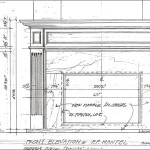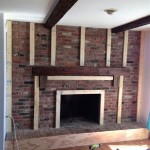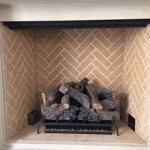Understanding Wood Fireplace Boxes: A Comprehensive Guide
The wood fireplace box, also known as a firebox or fire chamber, is the core component of a wood-burning fireplace. It serves as the contained space where wood is burned to generate heat and provide a visual focal point. Understanding its function, construction, and maintenance is crucial for safe and efficient fireplace operation. The integrity of the fireplace box directly impacts heating performance, smoke containment, and overall safety, making it a critical consideration for homeowners who utilize wood-burning fireplaces.
A properly functioning wood fireplace box is essential for channeling combustion byproducts up the chimney, preventing smoke from entering the living space. Its design aims to maximize heat radiation into the room while minimizing heat loss up the flue. Furthermore, a durable and well-maintained fireplace box protects the surrounding building materials from the intense heat of the fire, mitigating the risk of fire hazards.
Key Components and Construction
The construction of a wood fireplace box typically involves refractory materials designed to withstand high temperatures. These materials may include firebrick, cast iron, or a combination of both. Each material offers varying degrees of heat resistance, durability, and heat retention capabilities, influencing the overall performance and longevity of the fireplace. The selection of materials for a fireplace box is a key factor in determining its efficiency and lifespan.
Firebrick, a common choice, is a type of ceramic brick specifically formulated to withstand high temperatures without cracking or deteriorating. It is typically used to line the interior of the firebox, providing a protective barrier against direct flame contact. Firebrick offers excellent heat retention, gradually releasing heat into the room even after the fire has died down. However, firebrick can be susceptible to cracking over time due to thermal stress and requires periodic inspection and replacement.
Cast iron, another popular material, is known for its superior heat retention and durability. Cast iron fireplace boxes are often found in freestanding stoves and fireplace inserts. They can withstand extreme temperatures and are less prone to cracking than firebrick. However, cast iron can be more expensive than firebrick and may take longer to heat up initially. Its efficient heat radiation makes it a viable option for supplemental heating.
The dimensions and design of the fireplace box also play a significant role in its performance. A properly sized firebox allows for optimal airflow and combustion, ensuring efficient burning of wood. The shape of the firebox, whether rectangular, square, or arched, affects the way heat is radiated into the room. A well-designed fireplace box not only maximizes heat output but also contributes to the aesthetic appeal of the fireplace.
Mortar, a heat-resistant compound, is used to bind the firebrick or cast iron components together. Over time, the mortar can deteriorate due to exposure to high temperatures and acidic flue gases. Regular inspection of the mortar joints is essential to identify and repair any cracks or gaps. Deteriorated mortar can compromise the integrity of the fireplace box and lead to smoke leakage or structural damage.
Many modern fireplace boxes incorporate features such as air inlets and baffles to improve combustion efficiency. Air inlets provide preheated air to the fire, promoting cleaner and more complete burning of wood. Baffles are designed to redirect hot gases and increase their residence time within the firebox, allowing for more efficient heat transfer. These features contribute to reduced emissions and improved heating performance.
Factors Affecting Performance and Longevity
Several factors influence the performance and longevity of a wood fireplace box. These include the quality of the materials used in its construction, the types of wood burned, the frequency of use, and the maintenance practices employed. Neglecting these factors can lead to decreased heating efficiency, increased risk of fire hazards, and premature failure of the fireplace box. The type of wood burned profoundly affects the accumulation of creosote and how efficiently heat is given off.
The quality of the wood burned is a critical determinant of fireplace box performance. Burning seasoned, dry wood is essential for efficient combustion and minimizing creosote buildup. Wet or unseasoned wood burns inefficiently, producing more smoke and creosote. Creosote is a highly flammable substance that can accumulate in the chimney and fireplace box, increasing the risk of chimney fires. Using properly seasoned wood reduces creosote formation and promotes cleaner burning.
The type of wood burned also impacts heat output and the amount of ash produced. Hardwoods, such as oak, maple, and ash, generally burn longer and produce more heat than softwoods, such as pine and fir. Softwoods tend to burn faster and create more ash, requiring more frequent cleaning. Selecting the appropriate type of wood based on heating needs and fireplace design is important for optimal performance.
The frequency of fireplace use also influences its lifespan. Regularly used fireplaces are subjected to more thermal stress and wear and tear. Regular inspection and maintenance are particularly important for frequently used fireplaces. Addressing minor issues promptly can prevent them from escalating into more significant and costly repairs.
Maintenance practices play a vital role in extending the lifespan of a wood fireplace box. Regular cleaning of the firebox and chimney is essential for removing ash, creosote, and other debris. A professional chimney sweep should be hired annually to inspect and clean the chimney, ensuring it is free from obstructions and creosote buildup. Inspecting the firebox for cracks, gaps, or deteriorated mortar is also crucial for maintaining its integrity.
Creosote buildup is a major concern for wood-burning fireplaces. Creosote is a black, tar-like substance that condenses on the interior surfaces of the chimney and fireplace box. It is formed by unburned wood particles, smoke, and water vapor. Creosote is highly flammable and can ignite, causing a chimney fire. Regular chimney cleaning is essential for removing creosote and preventing chimney fires.
Maintenance and Repair Strategies
Maintaining a wood fireplace box involves regular inspection, cleaning, and repair. Addressing issues promptly can prevent further damage and ensure safe and efficient fireplace operation. Homeowners should familiarize themselves with basic maintenance procedures and seek professional assistance for more complex repairs. Simple maintenance can dramatically extend the life of the fireplace.
Regular inspection of the firebox should include checking for cracks, gaps, and deteriorated mortar. Any cracks or gaps should be repaired promptly using heat-resistant mortar. Deteriorated mortar should be removed and replaced with fresh mortar. It is important to use mortar specifically designed for fireplace applications to ensure it can withstand high temperatures.
Cleaning the firebox involves removing ash and debris after each use. Ash can be removed with a shovel and brush. Dispose of ash in a metal container with a tight-fitting lid. Never dispose of ash in a combustible container or leave it unattended, as hot embers can remain in the ash for several days. Regular ash removal helps maintain proper airflow and prevents creosote buildup.
Chimney cleaning should be performed annually by a qualified chimney sweep. A chimney sweep will inspect the chimney for obstructions, creosote buildup, and structural damage. They will use specialized tools to remove creosote and other debris from the chimney. A clean chimney is essential for safe and efficient fireplace operation.
Repairing a damaged firebox may involve replacing cracked or broken firebrick. Firebrick can be purchased at most hardware stores or fireplace supply retailers. When replacing firebrick, ensure it is properly sized and mortared in place. Follow the manufacturer's instructions for installation and use a heat-resistant mortar.
For more extensive repairs, such as replacing a damaged cast iron firebox or rebuilding a deteriorated firebox, it is best to seek professional assistance. A qualified fireplace technician can assess the damage and recommend the appropriate repair solution. They have the expertise and tools to perform complex repairs safely and effectively.
Preventative maintenance can significantly extend the lifespan of a wood fireplace box. This includes burning seasoned wood, cleaning the firebox regularly, scheduling annual chimney inspections, and addressing any minor issues promptly. By taking proactive steps to maintain their fireplace, homeowners can enjoy its warmth and beauty for many years to come.
Furthermore, ensuring proper ventilation around the fireplace is crucial. Avoid placing combustible materials too close to the fireplace box. Keep the area around the fireplace clear of clutter and flammable liquids. Install smoke detectors and carbon monoxide detectors in the vicinity of the fireplace to provide early warning of potential hazards.

36 Radiant Or Circulating Superior Wood Burning Fireplace Builders Merit Series Wct2036 Wrt2036

Lacua Silver 1000 Freestanding Wood Fireplace With Box Abbey Fireplaces

Barbas Box 20 75 Free Standing Wood Burning Stove Bonfire

Heatmaster Open Wood Fireboxes Fireplaces Heatworks

Stone Wood Burning Fireplace With Built In Box And Shelf 100 Yr Old Bard Mantel Ins Outdoor Design

Building A Firewood Box With Free Plans

What Is A Fireplace Firebox Full Service Chimney

Vent Free 50 Mosaic Masonry Fire Box Vrt6050 Superior Fireplace Vrt6000

Fireplace With Wood Storage Love The Next To Fire Place Farmhouse Design Brick

Osburn 3300 Wood Stove Ob03300
Related Posts








